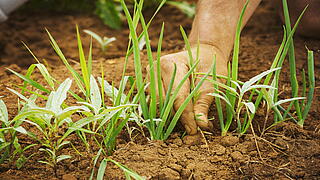No mosquitoes means no cocoa: how to save biodiversity

© fstopimages/Malte Müller
Biodiversity is much more than just the diversity of species. It also includes the diversity of ecosystems and the genetic diversity of organisms. So we humans are also part of the Earth's biodiversity. But the state of biodiversity is getting worse.
Biodiversity expert Judith Reise talks about the state of biodiversity, the causes of species loss and possible solutions to preserve it in the latest episode of Oeko-Institut's podcast 'All change please!
Listen here to the podcast 'Can biodiversity still be saved?'
The podcast audio is in German; an English translationis here.
Many interdependencies in the ecosystem
The interdependencies in the ecosystem are numerous and sometimes unknown. “The example of the mosquito, which many people hate, shows how important the contribution of individual species is to the ecosystem,” says Reise, “because without the gall midge, the cocoa tree would have a hard time. With its small size, it’s almost the only mosquito species that can pollinate the chocolate flower. So without the gall midge, there might be no chocolate.”
The most common causes of biodiversity loss, such as land-use change, pollution and climate change, are human-induced. Experts distinguish between direct and indirect factors that threaten the state of biodiversity.
In particular, intensive agriculture, fishing and forestry have a direct impact on our ecosystems. On the one hand, substances such as pesticides, insecticides and fertilisers are introduced. On the other, forests are cleared to make way for farmland, and the infrastructure of roads and settlements expands, causing forests and other ecosystems to disappear. Hunting and overfishing can also lead to the partial extinction of animal species. In addition, the introduction of new, sometimes invasive species puts pressure on existing ecosystems. Climate change is accompanied by higher temperatures, rising water levels or water shortages. As a result, some species lose their habitat, have to move or adapt, or even lose their livelihoods altogether.
Hunting and overfishing can also lead to the partial extinction of animal species. In addition, the introduction of new, sometimes invasive species puts pressure on existing ecosystems. Climate change is accompanied by higher temperatures, rising water levels or water shortages. As a result, some species lose their habitat, have to move or adapt, or even lose their livelihoods altogether.
There are also indirect drivers such as consumption, politics and the economy. In Germany, for example, we have higher taxes on plant-based products than on animal-based products. Organic products are expensive, and air travel is very cheap considering the emissions.
Active protection of ecosystems: less is more (diversity)
This makes it all the more important to take appropriate measures to promote and protect biodiversity. Agriculture should be adapted so that it does not exploit natural areas beyond their ecological limits. For example, crop rotations should be adapted, organic farming should be encouraged, the intensity of animal husbandry should be reconsidered and the introduction of substances should be minimised. Small-scale structures such as hedges, flower strips, fallow land and water bodies are desirable and worth protecting as habitats. Consumers can focus more on plant rather than animal products in their diets. Regional products and organic labelling provide good guidance when buying food, as pesticides are not used in organic farming. In forestry, active forest conversion is needed. Structures such as tree hollows and dead wood are recommended. Long-term forest management planning is needed as changes in the forest take a long time.
Policy framework conditions for biodiversity conservation
A concrete example at EU level is the so-called Nature Restoration Act, which was adopted in the summer of 2024. Member States have committed to restoring 20 per cent of currently degraded ecosystems by 2030, and all affected terrestrial and marine ecosystems by 2050. Measures include rewetting peatlands, restoring floodplains and converting monotonous and structurally poor forests into more diverse mixed forests.
Knowledge instead of everyday advice
Oeko-Institut’s podcast ‘All change please!’ is aimed at listeners from politics, research, the media, NGOs and the general public – anyone with an interest in political and environmental issues. It is hosted by Mandy Schossig, Head of Public Affairs & Communications, and Hannah Oldenburg, Digital Communications & Social Media Officer at Oeko-Institut. For about an hour – enough time for the ‘long haul of environmental podcasts’ - they talk to an expert from Oeko-Institut about the upcoming changes towards sustainability. The special episodes also address current political and social issues.
‘All change please!’ podcast: episodes of the 4th season
Episode 6 'Can biodiversity still be saved?' with Judith Reise, released on 19 September 2024
Episode 5 'How sustainable is artificial intelligence?' with Jens Gröger, released on 8 August 2024
Episode 4 'Can we still afford energy and mobility?' with Dr Viktoria Noka, released on 20 June 2024
Episode 2 'More speed in the energy transition?' with Moritz Vogel, released on 14 March 2024
All seasons and episodes of the podcast are available at www.oeko.de/podcast
The podcast is also available on all common podcast portals such as Apple Podcasts and Spotify.





